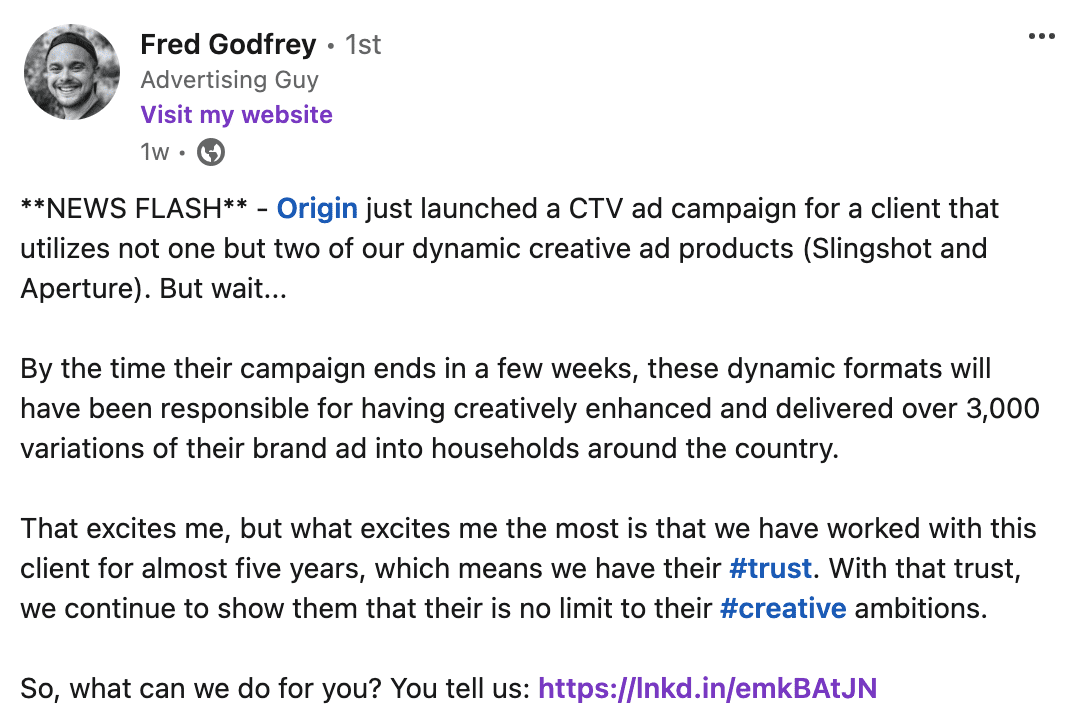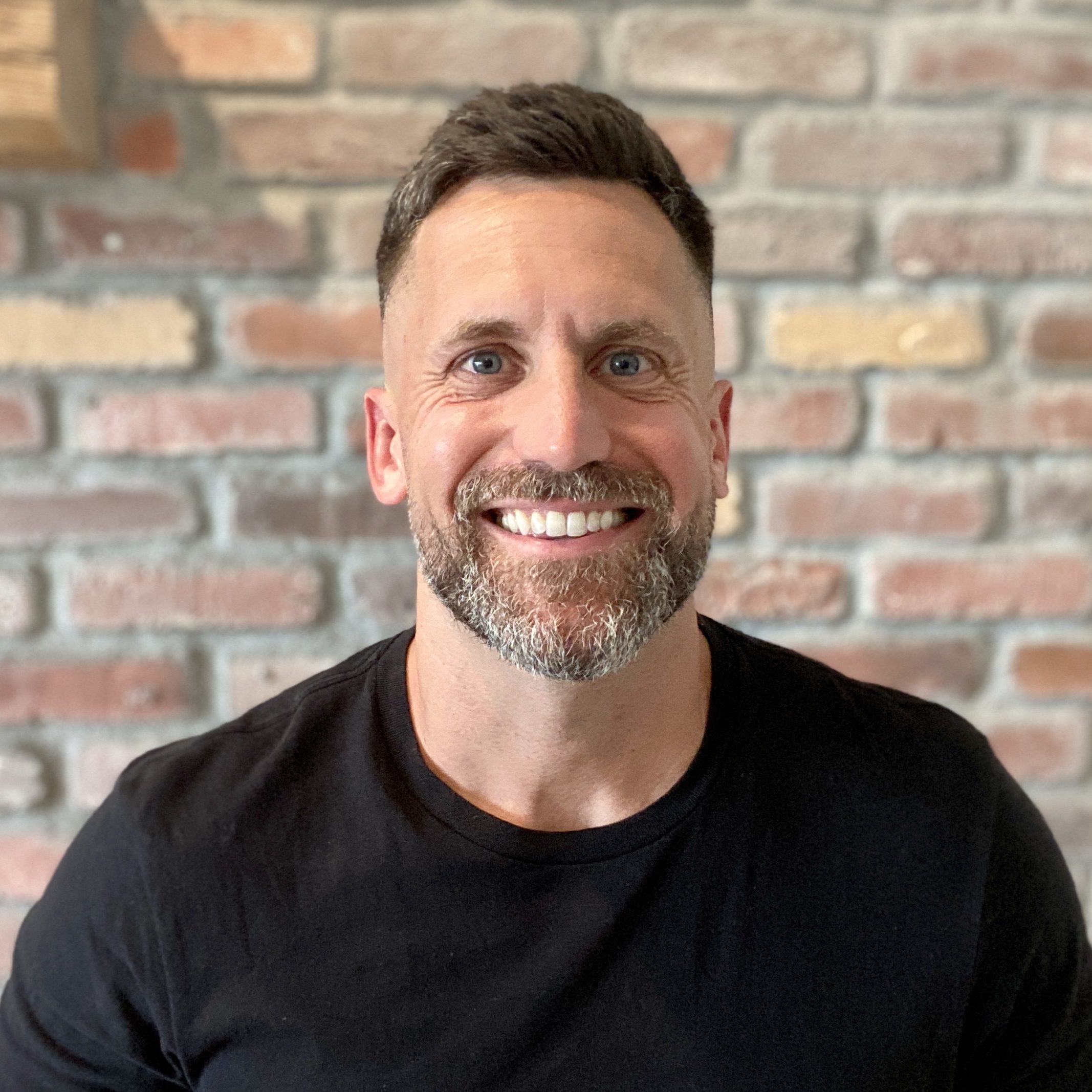Customer acquisition is important, but in my experience, the real value comes from what happens after you land a client. It’s all about building trust and delivering consistent results. As the 80/20 rule goes, 80% of your business comes from 20% of your clients—so keeping them happy isn’t just important; it’s critical.
I recently saw Fred Godfrey’s recent LinkedIn post about working with a client for five years—huge congrats on that milestone, Fred!

So, I had to reach out and catch up. For those unfamiliar, Fred is the CEO of Origin, a leading tech company offering no-code CTV ad solutions that help brands, media agencies, and creative teams capture attention, combat ad fatigue, and drive real performance outcomes. Let’s dive into what Fred and his team are working on at Origin these days.
Kirby: Fred, first off, congrats on the five-year partnership you mentioned in your LinkedIn post!
Fred: Thanks! It speaks to an amazing team and the creative solutions people are after. It’s wild to think that we started with just $30,000, and now here we are. Pretty awesome to see how far we’ve come.”
Kirby: How has building long-term relationships with clients helped Origin push the boundaries of CTV innovation?
Fred: Having long-term clients isn’t just about steady business—it’s a game-changer. The longer we work with a partner, the more they trust us. And with that trust, they start to see what we can really do creatively. Once they’re familiar with our capabilities, their campaign briefs get more ambitious. That’s when we can really start pushing the boundaries of what’s possible on CTV.
Kirby: Capturing and retaining viewer attention is a significant challenge in CTV. How does Origin ensure that ads are engaging enough to keep viewers watching?
Fred: I can’t dive too deep into the details, but the big idea is that we use a two-pronged strategy. First, we’re always researching, whether it’s running market surveys or even attaching electrodes to people’s heads—like we did in the MAGNA Media Trials. But more importantly, we’re constantly split-testing in the real world, watching how campaigns perform in real time. Second, we always think creatively from a consumer’s perspective—asking ourselves, ‘What would make me put my phone down during an ad break?
Kirby: Ad fatigue is a well-known issue in CTV advertising, with viewers seeing the same creative repeatedly. How do Origin’s solutions like Slingshot and Aperture help combat this problem?
Fred: When it comes to ad fatigue, whether it’s the brands we work with, the streaming services we buy media from, or the viewers we’re targeting, our goal is simple: not to add to the problem. We’ve built a suite of creative tools over the last five years to make sure viewers never see the same ad twice. We’ve taken dynamic creative optimization (DCO) up a level to what we call dynamic creative production (DCP).
On top of that, we’re also the media buyer for most of our clients, so we’re extra careful with how often we show a brand’s ad. In fact, our formats are so good at grabbing attention that we don’t need to bombard viewers. For example, one recent campaign exceeded its goals with just one ad exposure per household per month!
This approach means:
- The risk of ‘negative sentiment’—where viewers get annoyed with a brand from seeing an ad too much—is basically nil.
- Our clients get more bang for their buck since their campaign goals are met more efficiently.
Kirby: In one of your recent articles, you discussed the balance between personalization and broader storytelling. How does Origin approach creating ads that are both personally relevant and able to spark wider cultural conversations?
Fred: In a way, a lot of what I’ve already mentioned covers this. By giving brands the ability to say what they want, to whom they want, and when they want, we give them the flexibility to tell stories that really hit home on a personal level. For most, data is just used to decide where to place an ad, but for us, it goes deeper into the creative—what it looks like, what it says, and more. If anyone’s interested in digging into this topic, we’ve written a few articles about it:
- Immersive advertising and how the right strategy can go beyond personalization.
- Co-viewing in an age of hyper-targeting.
Kirby: While CTV is growing, traditional TV still commands a significant share of ad budgets. What do you think is preventing CTV from fully dominating the advertising landscape?
Fred: I’ll keep this brief and as edgy/risky as it might be, I’ll point you to an interview I did a while back where I talked about ‘the dinosaurs of Madison Avenue.
Kirby: Immersive advertising is becoming more prevalent, especially when it comes to personalization and real-time relevance. How is Origin positioning itself at the forefront of this movement?
Fred: To put it simply, we’re never fully satisfied with the level of creative agility we offer our clients. We’re investing heavily in R&D, and every day we get a little closer to delivering true, real-time creatives—think betting odds during a game or even live weather updates. And we’re doing all of this without needing any special SDK or fancy tech. That’s a key part of our creative stack—everything we serve is just a simple, flat mp4 file. It’s a lot harder to pull off, but it means brands working with Origin don’t have to worry about reach, scale, or reliability.
Kirby: Looking ahead, where do you see CTV advertising evolving, particularly in terms of how brands can create more engaging and meaningful connections with their audiences?
Fred: Breaking the ad break. Think about it—the concept of a commercial break hasn’t changed in 75 years. We stop someone’s show and make them watch a bunch of ads in the hope they’re paying attention. While the solutions we’ve developed at Origin work really well within those traditional limits, here’s a little secret: that’s not where our vision ends. It’s just the beginning. We’re aiming to completely change how brands exist on TV, in a way that aligns with how people’s habits and expectations have evolved. I’ll leave you with two words: Value. Exchange.
I want to thank Fred for taking the time to share his insights and perspectives on the evolving CTV landscape. In addition to this Q&A, Fred and I had a separate 50-minute conversation, which you can watch below. It’s clear that the industry is changing rapidly, and discussions like this help shed light on where things might be headed. We’ll be keeping an eye on how these innovations continue to shape the future of CTV advertising.
If you want more information about Fred and the innovative work happening at Origin, be sure to check out Origin’s website and connect with Fred Godfrey on LinkedIn to stay updated on their latest advancements in CTV advertising.
We’d love to hear your thoughts! How do you see the future of CTV advertising evolving? Share your insights in the comments and join the conversation on what’s next for the industry.







